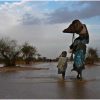
Author and Page information
- This page: https://www.globalissues.org/article/805/cop20-lima-climate-conference.
- To print all information (e.g. expanded side notes, shows alternative links), use the print version:
On this page:
Introduction
 December 1 – 14, 2014, Lima, Peru was the venue for the 20th annual United Nations Climate Change Conference, also known as the 20th Conference of the Parties — or COP 20.
December 1 – 14, 2014, Lima, Peru was the venue for the 20th annual United Nations Climate Change Conference, also known as the 20th Conference of the Parties — or COP 20.
The purpose of this conference was to create a universal agreement on climate change action and begin the process of financing mitigation.
Meeting outcome
The meeting ended with all nations agreeing to cut back greenhouse gas emissions. Known as the Lima Accord, this treaty is not legally binding and countries do not have to specify how much they will cut back, instead agreeing to report their plans back by March 2015.
While for many it sounded like a successful outcome, others were disappointed, such as poor countries struggling to rebuild from current impacts of climate change who were alarmed at the disappearance of loss and damage commitments from the final text which has been part of the discussion for years.
The global climate movement, 350.org, summarized the disappointments and hopeful aspects of the meeting outcome, noting
- The new agreement does not reflect the urgency of the climate crisis
- Some good agreements – but no measures to ensure implementation
- Least developed and vulnerable nations left out in the cold
- Divestment (from fossil fuel reliance) is more important than ever
- Global momentum for real solutions is stronger than ever and will keep on going.
In trying to put a positive spin on the overall disappointment they felt, they concluded, In the end, a global climate treaty is just one tool to combat climate change. Real change is going to continue to come from the grassroots. The UN Climate Talks continue to be a place where the world’s countries comes together to debate this crisis and people are putting in enormous efforts to make sure Paris [the next global meeting] won’t be like Copenhagen
which was full of disappointments despite big promises.
Samantha Smith, Leader of WWF’s Global Climate and Energy Initiative, was quite scathing of the meeting outcome saying that political expediency won over scientific urgency
. She also noted that Developed country governments couldn’t even manage to explain how they will deliver the long-promised US$100 billion per year in climate finance by 2020. In a move that seemingly dismissed the plight of the most vulnerable countries, they completely removed any meaningful language about ‘loss and damage’.
Mainstream media reporting
As with almost every previous meeting (with occasional exceptions), mainstream media reporting was very poor given the importance of this global issue. Where the meeting was reported it was generally towards the end, and just sound bite type summaries saying all countries agreed to emission cuts and that this was a major improvement.
While the treaty continued to say it honors the long-standing common but differentiated responsibilities
the mainstream media reporting (as in most years) has typically failed to provide explanation and context of this principle that has been an important part of these talks for over 2 decades; that poor and developing countries should not bear the same responsibilities as the developed ones (because they are not the cause of the anthropogenic carbon emissions over the previous decades that have led to this, which is detailed much more on this site’s page on climate justice).
A hint towards this principle may have been presented as a viewpoint of China or India, given the impression they are being obstacles, rather then explaining this principle in more context.
That was just one of the issues skirted over or omitted from common reporting. Others included issues on financing, technology support for poorer nations, etc. Behind the scenes, for decades, rich countries have stalled on these things or actively avoided trying to share technology etc, which is barely reported.
Every year, this criticism is made of mainstream reporting, so without following these negotiations each year, it can be easy to come away with the impression that this meeting had a positive outcome.
But as this discussion hosted by Democracy Now! shows, there were a number of important issues of contention:
In context: common but differentiated responsibilities
Many years ago all nations agreed that climate change was largely the result of actions from today’s industrialized nations, as carbon dioxide — the main greenhouse gas — stays in the atmosphere for decades. Yet, the poorest would end up suffering the most for a problem they largely did not cause. The approaches to mitigation (emissions reduction) would therefore be different for those groups of countries — the common but differentiated responsibilities principle.
It is in this context that the discussion for loss and damage has come about. And it is something that rich countries are keen to get rid of .
The years of resistance on this issue (and many others) means each time it is discussed again the reactions seem to get even more hostile. Combined with the lack of detailed context in the mainstream media coverage of this aspect, it then becomes easier each time to see culprits as China and India given their enormous greenhouse emissions in recent years, compared to the far greater amount by the industrialized nations over the longer period. See this site’s section on climate justice for more detailed background.
And as this site has said for years on the climate justice page, the rich nations are delaying any meaningful action until it is eventually — and disproportionately — paid for the by the developing nations. New Delhi based Nitin Sethi, associate editor at Business Standard, interviewed in the earlier mentioned video says the same thing, but more frankly:
There is no action that’s going to happen between now and 2020. All of that was to be done by the developed countries. They [rich nations] basically have just said at Lima that
we are not going to do any more than what we’re doing so far, and the burden can shift onto the post-2020 era, where other developing countries have to share it.So, to me, it indicates really negotiation in bad faith.
More information
As the conference is still underway as this page is written, more information will be added here after the event is over.
For more about the issues from other organizations, here are some starting points:
News stories from IPS
Below is a list of stories from Inter Press Service related to the Lima climate conference and its aftermath.
-
World must ‘change track’ to protect oceans from climate crisis: Guterres
– UN News

The planet is facing the triple crises of climate disruption, biodiversity loss and pollution, Secretary-General António Guterres told the One Ocean Summit on Friday, warning that “the ocean shoulders much of the burden”.
-
Wetlands: ‘Unsung heroes’ of the climate crisis
– UN News

For the first time, the United Nations on Wednesday celebrates World Wetlands Day, recognizing that these fragile ecosystems make a crucial contribution to biodiversity, climate mitigation, freshwater availability, and economic resilience.
-
2021 Year in Review: Climate action, or blah, blah, blah?
– UN News

This year saw another steady stream of UN-backed reports reinforcing a stark message: man-made climate change is an urgent and even existential threat to life on Earth. Will the international community’s efforts to tackle the crisis, as seen at the COP26 UN Climate Conference, result in meaningful action?
-
Uruguay Launches Sovereign Bond Linked to Climate Targets
– Inter Press Service

BUENOS AIRES, Dec 23 (IPS) – Sustainable finance continues to expand in Latin America, as governments and companies take advantage of growing interest among investors in instruments that protect biodiversity and respond to the climate crisis. In 2020, more than US$16 billion of green, social and sustainable bonds were issued in the region.
-
Blue Ocean Solutions for Climate Resilience and Accelerated Development
– Inter Press Service

Nairobi, Kenya, Dec 22 (IPS) – Seychelles’ 115 islands are an exotic ocean ecosystem of beaches, coral reefs, and unique plant and animal species. Concerned with the impacts of climate change, the country has committed to decarbonize by 2050.
-
Nature-based Solutions for enhancing coordinated action around climate change, land and biodiversity
– Inter Press Service

London, Dec 17 (IPS) – A key outcome of COP26 climate summit is the enhanced focus on “nature-based solutions” – the plans for people to work closely alongside nature to avert a planetary catastrophe.
-
UN rights forum’s action on climate and COVID-19 vaccines shows its relevance, says President
– UN News

After one of the busiest years in the history of the Human Rights Council, President Nashat Shameem Khan insisted on Thursday that the UN forum remains more relevant than ever, citing action on COVID-19 vaccine inequity, climate change and no less than five Special Sessions in Geneva.
-
Youth at Forefront of Climate Change Action Will Make Biggest Impact
– Inter Press Service

Nairobi, Kenya, Dec 15 (IPS) – On Gladys Habu’s birthday, she filmed a message to world leaders while standing waist-deep in the sea next to a dead tree stump – the only remnant of Kale Island now submerged underwater due to climate-change-induced sea-level rise.
-
Climate change ‘aggravating factor for terrorism’: UN chief
– UN News

Environmental degradation enables armed groups to extend their influence and manipulate resources to their advantage, the UN chief told the Security Council on Thursday, highlighting that conflict-prevention initiatives need to factor in climate risks.
-
Climate Crisis Exacerbates Urban Inequality in Latin America
– Inter Press Service

RIO DE JANEIRO, Dec 08 (IPS) – The Brazilian megalopolis of São Paulo recorded 932 flooded premises on Feb. 10, 2020. The Mexican city of Tula de Allende was under water for 48 hours in September 2021. In Lima it almost never rains, but the rivers in the Peruvian capital overflowed in 2017 and left several outlying municipalities covered with mud.
-
Climate Change: Adapt for the Future, Not the Past
– Inter Press Service

SYDNEY and KUALA LUMPUR, Dec 07 (IPS) – Funding for developing countries to address global warming is grossly inadequate. Very little finance is for adaptation to climate change, the urgent need of countries most adversely affected. Also, adaptation needs to be forward-looking rather than only addressing accumulated problems.
-
From the Field: ‘climate-smart’ development in an uncertain world
– UN News

Today, when the UN plans initiatives to help vulnerable communities become more resilient, the climate crisis has to be part of the equation. The UN Development Programme (UNDP) is connecting the dots between people and the impacts that climate change is having on their lives.
-
COP26: Convert climate ‘promises to action’, urge UN rights experts
– UN News

Marking the 35th anniversary of the Declaration on the Right to Development, independent UN human rights experts on Friday issued an urgent call to “move from promises to action” on the outcomes of the UN’s landmark COP26 climate conference.
-
What Will it Take to Turn Farmers Toward Climate-Resilient Superfood Millet?
– Inter Press Service

Bulawayo, ZIMBABWE , Dec 1 2021 (IPS) – Millet could be Africa’s silver bullet for combating anaemia – and apart from health benefits, it is climate-resilient.
-
Climate Change with 8 Billion Humans
– Inter Press Service

PORTLAND, USA, Nov 23 (IPS) – With world population approaching 8 billion humans, the demographic growth of nations is unfortunately largely ignored by governments whenever climate change is considered.
-
Interview: The most impactful actions at COP26 point to progress on climate change
– UN News

Of the many agreements and initiatives announced at the 26th UN Climate Conference (COP26) in Glasgow, the UN Climate Communications Lead at the Department of Global Communications narrowed down the three that she deemed most impactful.
-
What Governments Should Learn from The Climate Activists
– Inter Press Service

Nov 15 (IPS) – Shantha Rau Barriga is the disability rights director and the lead on Strategy Development at Human Rights Watch“Nothing about us without us” – that was the call from the indigenous rights advocate Ghazali Ohorella from the Alifuru people in the Maluku Islands, Indonesia during a panel at the climate summit in Glasgow.
-
Glasgow Summit Ends Amidst Climate of Disappointment
– Inter Press Service

GLASGOW, Nov 14 (IPS) – Developing countries will surely remember the Glasgow climate summit, the most important since 2015, as a fiasco that left them as an afterthought.
-
COP26 closes with ‘compromise’ deal on climate, but it’s not enough, says UN chief
– UN News

After extending the COP26 climate negotiations an extra day, nearly 200 countries in Glasgow, Scotland, adopted on Saturday an outcome document that, according to the UN Secretary-General, reflects the interests, the contradictions, and the state of political will in the world today.
-
Climate action can deliver a sustainable future for all: UN deputy chief
– UN News

Climate action can be the driver for a green and equitable future for all, UN Deputy Secretary-General Amina Mohammed has said at the TED Countdown Summit, urging people everywhere to demand that leaders deliver on their promise to limit global warming.
-
As COP26 deadline slips, negotiators to keep working to agree crucial climate deal
– UN News

COP26, the UN climate summit in Glasgow, is running into overtime, as leaders and negotiators will keep working to reach a deal that could spare the world from catastrophic global warming.
-
Violence, insecurity and climate change drive 84 million people from their homes
– UN News

As more people flee violence, insecurity and the effects of climate change, the number forcibly displaced now exceeds 84 million globally, according to new data released on Thursday by the UN refugee agency, UNHCR.
-
COP26: Climate Action in Agribusiness Could Reduce Emissions by up to 7 per Cent
– Inter Press Service
-
UN chief welcomes China-US pledge to cooperate on climate action
– UN News

Wednesday’s announcement that China and the United States have agreed to collaborate more closely on climate action was hailed by UN Secretary-General António Guterres as an important step in the right direction.
-
Climate change increasing threats in southwest Pacific: WMO report
– UN News

From rising sea temperatures, to deadly and devastating storms and floods, climate change is increasing threats in the southwest Pacific, the World Meteorological Organization (WMO) said in a report published on Wednesday.
-
COP26: Avoiding Carbon Tunnel Vision: Action on Climate Change Needs an Inter-connected Response
– Inter Press Service

AMSTERDAM, the Netherlands, Nov 10 (IPS) – With the UN climate change conference – COP26 – continuing this week in Glasgow, it’s obvious that there is consensus among a majority of world leaders and key stakeholders that much more needs to be done, if the ambition of keeping global warming to a 1.5-degree increase is to have any chance of being met. Yet talk, as they say, is cheap. Or, in the words of Greta: too much “blah, blah, blah” and not enough action.
-
COP26 – Adapting to the Climate Crisis
– Inter Press Service

OTTAWA, Canada, Nov 09 (IPS) – Look up any map showing today’s global humanitarian crises and you’ll find it awash in red alerts more than ever before. Climate emergencies are fast emerging in new areas that have never previously witnessed them, and they are accelerating humanity’s march towards the precipice in regions long battered by conflict, hunger and displacement.
-
Magical Thinking on Fertilizer and Climate Change
– Inter Press Service

CAMBRIDGE, Nov 09 (IPS) – As world leaders wrap up the UN Climate Summit in Glasgow, new scientific research shows that there is still a great deal of magical thinking about the contribution of fertilizer to global warming.
-
COP26: Climate Justice Begins with the Human Right to Water
– Inter Press Service

GLASGOW, Scotland, Nov 09 (IPS) – As the UN Climate Change Conference (COP26) is swiftly moving to its conclusion on Friday, climate justice could not be more urgent or timely.
-
Women bear the brunt of the climate crisis, COP26 highlights
– UN News

Women took the global stage on Tuesday to show that climate change isn’t gender neutral, and that climate action needs them: investing in women and girls creates ripple effects felt throughout entire communities and the frontline knowledge they possess is needed now more than ever, especially as new analysis has revealed that the announcements by world leaders at COP26 still leave our planet on the path to catastrophic global warming.
Author and Page Information
- Created: